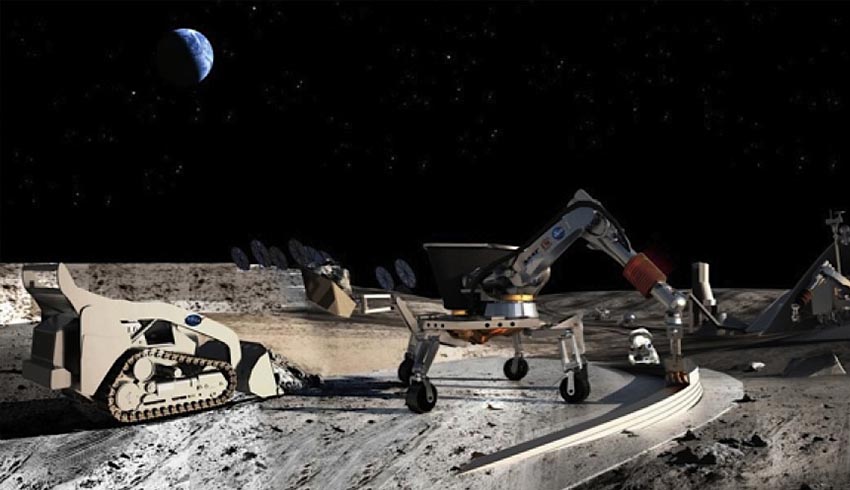
Seven Sisters is the Australian Lunar Exploration Mission to send nanosatellites and exploration sensors to the Moon to search for abundant, accessible water and resources in 2023, supporting NASA’s Artemis Program.
Led by a world-class consortium of space, industry and research leaders, Seven Sisters is a purpose-driven mission of discovery. Fleet Space Technologies, OZ Minerals, University of Adelaide, UNSW, Unearthed, Tyvak Australia and Fugro are already developing advanced technologies that will transform space exploration.
Fleet Space CEO, Flavia Tata Nardini said, “We are thrilled to launch our mission utilising the best of Australia’s capabilities. It is critical that Australia supports NASA’s Artemis Program with high-maturity systems.”
The founding members pledged their support in 2019 and have spent 2020 adapting proven technologies for this ground-breaking mission.
With Fleet Space’s Centauri constellation already operating in Low Earth Orbit and the first generation of prototype probes being deployed and tested this summer, the mission is already proving hardware and space systems for future use on the Moon and Mars.
“Our satellites are already in space and our consortium members have proven capabilities in the most demanding environments on Earth. We are ready” Nardini added.
A key goal of the Seven Sisters Program is to secure Australia’s place as a specialist leader in space exploration by 2030. This inspirational, high-impact Australian mission will leverage the existing private investment in Australian space technology, as well as Australia’s core strengths in remote operations, communications and exploration.
Developing an exceptionally strong Australian space sector will create thousands of high-technology jobs along the way.
Seven Sisters mission director Matt Pearson added, “This is the space race Australia can win. Ultimately we are seeking footholds on these new worlds. In-situ resource utilisation is key to having permanent bases on the Moon, Mars and beyond.”
South Australian Premier Steven Marshall said the program was a fantastic example of the capability of South Australia’s space industry to collaborate on the kind of major space exploration projects that will secure the state’s place in the global space race.
“Fleet Space Technologies has reached tremendous heights since it was established here in Adelaide, well and truly cementing itself as a major player in our state’s booming space industry. This program shows how vital collaboration within the industry is to our national success in this emerging sector. We are fortunate to have some of the brightest minds in space living and working here in South Australia and it is fantastic to see what can be achieved when these minds come together,” Premier Marshall added.
The Seven Sisters name is inspired by the star cluster known as the Seven Sisters or the Pleiades, which represents an important story of Seven Sisters in both Aboriginal star dreaming stories and in Ancient Greek mythology.
The Seven Sisters were the companions of Artemis, and this name was chosen as Australia embarks on a companion mission to NASA’s Artemis Program: to land the first woman and next man on the Moon by 2024.
Seven Sisters is developing new resource exploration techniques for Earth, the Moon and Mars.
These tools will help NASA identify viable deposits of water and other resources more efficiently. Ultimately, this work will underpin further exploration throughout our solar system.
Using massive arrays of sensors on the lunar surface to generate rich images of subsurface water and mineralisation, Artemis will be equipped with the data it needs to make prudent decisions ahead of robotic and human exploration.
Professor Andrew Dempster, director of the Australian Centre for Space Engineering Research (ACSER) explained, “Australia is a world leader in mining engineering research and automation. It has the largest resources companies and it makes a lot of sense for our young space industry to concentrate on an area of Australian strength. The Seven Sisters mission offers a real opportunity to leverage strong Australian technology to promote human endeavours on the moon.”
Back on Earth, cutting-edge space technology developed through the Seven Sisters Mission will be utilised for terrestrial exploration, renewing our resource industry on Earth with new opportunities. These new techniques are already being trialled in South Australia as part of the Accelerated Discovery Initiative.
Gavin Gillett of the Pioneer Lab at Rio Tinto added, “Australia has a unique combination of geography, environment and demographics that make pioneering automation and robotics a necessary part of our DNA. We partner with the space industry to stream oceans of data through satellites.”
With the paramount importance of STEM to this future industry in Australia, The Seven Sisters Explorers Program was also announced, a chance for Australian students and graduates interested in geoscience, engineering, computer science and robotics to join this mission to the moon.
Explorers will gain access to new roles, take part in terrestrial geoscience missions, cutting-edge analysis and inspirational space engineering programs.
Fleet Space Technologies is an Australian satellite company building a global digital nervous system to power the next industrial revolution. Backed by Blackbird Ventures, Horizons Ventures and Mike Cannon-Brookes, the company was founded in South Australia in 2015 and made history by launching Australia’s first commercial nanosatellites in 2018, the beginning of a planned constellation of 140 LEO nanosatellites that will connect billions of digital sensors already transforming industries from energy and utilities to mining.
Fleet Space is scheduled to launch its next generation of nanosatellites in 2021.
Receive the latest developments and updates on Australia’s space industry direct to your inbox. Subscribe today to Space Connect here.









